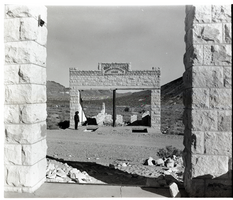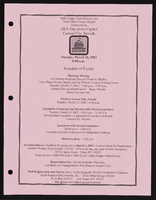Search the Special Collections and Archives Portal
Search Results

Transcript of interview with Floyd Jenne by Ping Lee, March 10, 1981
Date
Archival Collection
Description
On March 10, 1981, Floyd Jenne (born June 6th, 1915 in Ogden, Utah) was interviewed by Ping Lee at the University of Nevada, Las Vegas. The interview covers Mr. Lee’s life as a police officer in Boulder City, Nevada. Mr. Lee also recalls going to school in McGill, Nevada and Ely, Nevada and working in Boulder City and Las Vegas, Nevada.
Text

Interview with Robert Martin "Doc" Campbell, Jr., March 12, 2005
Date
Archival Collection
Description
Text

Film transparency of the ruins of the H. D. and L. D. Porter Brothers Store, Rhyolite, Nevada, November 25, 1948
Date
Archival Collection
Description
Image

City of Las Vegas building codes, notices, correspondence
Date
Archival Collection
Description
City of Las Vegas building codes, notices, correspondence
Text

James Dean Leavitt oral history interviews: transcript
Date
Archival Collection
Description
Oral history interviews with James Dean Leavitt conducted by Claytee D. White on September 27 and October 4, 2022 for the Boyer Early Las Vegas Oral History Project. In this interview, Leavitt recalls his role in establishing a medical school at the University of Nevada, Las Vegas (UNLV), now known as Kirk Kerkorian School of Medicine. Leavitt was elected to the Board of Regents in 2004 while Jim Rogers was interim Chancellor of the Nevada System of Higher Education (NSHE), and he suggested the creation of an ad hoc committee Health Science Center Committee. In 2009, Leavitt became Chairman of the Board of Regents, Dan Klaich became Chancellor, and in the following year, Dr. Mark Doubrava joined the board. In May 2014, the planning dean was hired, Dr. Barbara Atkinson, and the UNLV School of Medicine was officially established on August 22, 2014.
Text

Alpha Kappa Alpha Sorority, Theta Theta Omega Chapter "AKA Day at the Capitol" schedule and supplementary resources
Date
Archival Collection
Description
From the Alpha Kappa Alpha Sorority, Incorporated, Theta Theta Omega Chapter Records (MS-01014) -- Chapter records file.
Text
Juanita Greer White Photographs
Identifier
Abstract
The Juanita Greer White Photographs (approximately 1960-1979) depict Dr. Juanita Greer White’s activities in politics and higher education in Southern Nevada. Images depict Dr. Greer White receiving a Distinguished Nevadan Award, acting as a Nevada Delegate for the National Conference on Aging, and her time spent in the Nevada State Legislature.
Archival Collection
Nevada Women’s Conference Photograph Collection
Identifier
Abstract
The Nevada Women’s Conference Photograph Collection depicts the statewide women’s conference held in June 1977 in Las Vegas, Nevada. The photographs include keynote speaker Gloria Steinem, event organizers, workshops, volunteers, and musical performances.
Archival Collection
Grace Hayes Papers
Identifier
Abstract
The Grace Hayes Papers (1900-1989) include personal papers and financial papers pertaining to the Grace Hayes Lodge (formerly the Red Rooster), a nightclub on the Strip in Las Vegas, Nevada. The collection includes financial documents, newspaper clippings about Hayes and her family, personal correspondence, career mementos, legal documents, and photograph albums.
Archival Collection

Meeting minutes for Consolidated Student Senate, University of Nevada, Las Vegas, September 18, 2000
Date
Archival Collection
Description
Text
